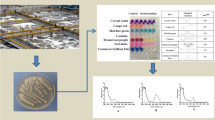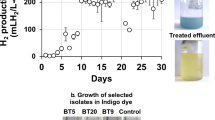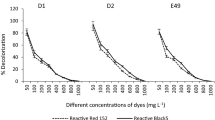Abstract
A new species of genus Shewanella, Shewanella decolorationis S12, from activated sludge of a textile-printing wastewater treatment plant, can decolorize Reactive Brilliant Blue K-GR, one kind of anthraquinone dye, with flocculation first. Although S. decolorationis displayed good growth in an aerobic condition, color removal was the best in an anaerobic condition. For color removal, the most suitable pH values and temperatures were pH 6.0–8.0 and 30–37°C under anaerobic culture. More than 99% of Reactive Brilliant Blue K-GR was removed in color within 15 h at a dye concentration of 50 mg/l. Lactate was the suitable carbon source for the dye decolorization. A metal compound, HgCl2, had the inhibitory effect on decolorization of Reactive Brilliant Blue K-GR, but a nearly complete decolorization also could be observed at a HgCl2 concentration of 10 mg/l. The enzyme activities, which mediate the tested dye decolorization, were not significantly affected by preadaptation of the bacterium to the dye.








Similar content being viewed by others
References
Bowman JP, McCammon SA, Nichols DS, Skerratt JH, Rea SM, Nichols PD, McMeekin TA (1997) Shewanella gelidimarina sp. nov., and Shewanella frigidimarina sp. nov., novel Antarctic species with the ability to produce eicosa-pentaenoic acid (20:5ω3) and grow anaerobically by dissimilatory Fe(ÉÉÉ) reduction. Int J Syst Bacteriol 47:1040–1047
Bozal N, Montes MJ, Tudela E, Jiménez F, Guinea J (2002) Shewanella frigidimarina and Shewanella livingstonensis sp. nov. isolated from Antarctic coastal areas. Int J Syst Evol Microbiol 52:195–205
Chen KC, Huang WT, Wu JY, Houng JY (1999) Microbial decolorization of azo dyes by Proteus mirabilis. J Ind Microbiol Biotech 23:686–690
Chen KC, Wu JY, Liou DJ, Hwang S-CJ (2003) Decolorization of the textile dyes by newly isolated bacterial strains. J Biotechnol 101:57–68
Dong X, Zhou J, Liu Y (2003) Peptone-induced biodecolorization of reactive brilliant blue (KN-R) by Rhodocyclus gelatinosus XL-1. Process Biochem 39:89–94
Haug W, Schmidt A, Nörtemann B, Hempel DC, Stolz A, Knackmuss HJ (1991) Mineralization of the sulfonated azo dye mordant yellow 3 by a 6-aminophthalene-2-sulfonated-degrading bacterial consortium. Appl Environ Microbiol 57:3144–3149
Itoh K, Yatome C, Ogawa T (1993) Biodegradation of anthraquinone dyes by Bacillus subtilis. Bull Environ Contam Toxicol 50:522–527
Ivanova EP, Sawabe T, Gorshkova NM, Svetashev VI, Mikhailov VV, Nicolau DV, Christemj R (2001) Shewanella japonica sp. nov. Int J Syst Evol Microbiol 51:1027–1033
Jian H, Tso W, Tso M, Zhang X, Xu M, Deng S, Sun G (2001) Broad spectrum decolorizing bacterial strains and their functional plasmids. In: Healy M, Wise DL, Moo-Young M (eds) Environmental monitoring and biodiagnostica of hazardous contaminants. Kluwer, Dordrecht, pp 97–104
Kapdan IK, Kargi F, McMullan G, Marchant R (2000) Effect of environmental conditions on biological decolorization of textile dyestuff by C. versicolor. Enzyme Microb Technol 26:381–387
Myers CR, Nealson KH (1988) Bacterial manganese reduction and growth with manganese oxide as the sole electron acceptor. Science 240:1319–1321
Nigam P, Singh D, Marchant R (1996) An investigation of the biodegradation of textile dyes by aerobic and anaevolic microorganisms. In: Moo-young M, Amderson WA, Chakrabarty AM (eds) Environmental biotechnology: principles and applications. Kluwer, Dordrecht, pp 278–287
Petrovskis EA, Vogel TM, Adriaens P (1994) Effects of electron acceptors and donors on transformation of tetrachloromethane by Shewanella putrefaciens MR-1. FEMS Microbiol Lett 121:357–364
Ramalho PA, Scholze H, Cardoso MH, Ramalho MT, Oliveira-Campos AM (2002) Improved conditions for the aerobic reductive decolourisation of azo dyes by Candida zeylanoides. Enzyme Microb Technol 31:848–854
Russell NJ, Nichols DS (1999) Polyunsaturated fatty acids in marine bacteria—a dogma rewritten. Microbiology 145:767–779
Semple KM, Westlake DWS (1987) Characterization of iron reducing Alteromonas putrefaciens strains from oil field fluids. Can J Microbiol 35:925–931
Soares GMB, Costa-Ferrerira M, Amorim MTP (2001) Decolorization of an anthraquinone-type dye using a laccase formulation. Bioresour Technol 79:171–177
Walker MG, Weatherly RL (2000) Biodegradation and biosorption of acid anthraquinone dye. Environ Pollut 108:219–223
Xu M, Guo J, Cen Y, Zhong X, Cao W, Sun G (2005) Shewanella decolorationis sp. nov., decolorizing bacterium isolated from activated sludge of a waste-water treatment plant. In J Syst Evol Microbiol 55:363–368
Yatome C, Ogawa T, Matsui M (1991) Degradation of crystal violet by Bacillus subtilis. J Environ Sci Health Part A Tox Hazard Subst Environ Eng 26:75–87
Zimmermann T, Kulla HG, Leisinger T (1982) Properties of purified orange (II) azoreductase, the enzyme initiating azo dye degradation by Pseudomonas KF46. Eur J Biochem 129:197–203
Zissi U, Lyberatos G, Pavlou S (1997) Biodegradation of p-aminoazobenzene by Bacillus subtilis under aerobic conditions. J Ind Microbiol Biotechnol 19:49–55
Zollinger H (1987) Color chemistry: syntheses, properties, and application of organic dyes and pigments. VCH, New York, pp 92–102
Acknowledgements
This work was supported by the funds of Chinese National Programs for High Technology Research and Development (No. 2001AA214111), Guangdong Provincial Natural Science Fund (No. 015017), Guangdong Provincial Natural Science Fund (No. 04000242), and Guangdong Provincial Natural Science Fund (No. 05100365).
Author information
Authors and Affiliations
Corresponding author
Rights and permissions
About this article
Cite this article
Xu, M., Guo, J., Zeng, G. et al. Decolorization of anthraquinone dye by Shewanella decolorationis S12. Appl Microbiol Biotechnol 71, 246–251 (2006). https://doi.org/10.1007/s00253-005-0144-1
Received:
Revised:
Accepted:
Published:
Issue Date:
DOI: https://doi.org/10.1007/s00253-005-0144-1




